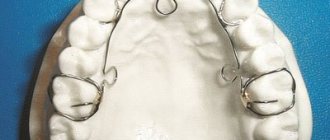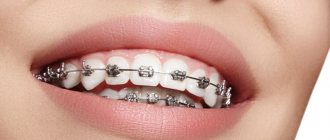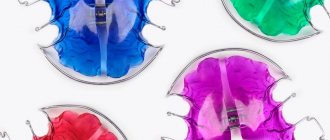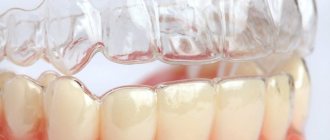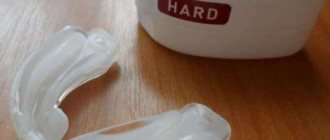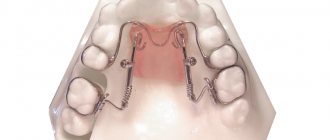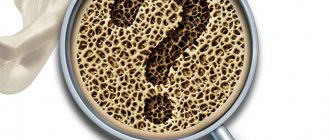Are you planning microimplant orthodontic treatment with the installation of braces? Perhaps you, as a potential patient, are considering microimplants as an alternative to traditional implants that are screwed into the bone? Everything you need to know about microimplants, indications for their use and possible contraindications is in our material. Experts share their independent opinions and reveal facts that are not always discussed in dentistry. Read the material to the end to be aware of all the important nuances.
General information about microimplants
Microimplants are small (about one millimeter in diameter) titanium pins that are screwed into the patient’s bone and pass through the gums, thereby providing a reliable support for the orthodontic brace system. They perform a temporary function if they are placed during orthodontic treatment.
Visually, a microimplant is similar to a miniscrew, but has a specific head. The total length of the microimplant is from 0.6 to 1.2 cm. Unlike classical implants, the microimplant is screwed into the patient’s gums and, if necessary, can be removed without damaging living tissue.
Specifics of device operation
The principle of correcting malocclusions is based on mechanical action on a specific area. In this case, the impact must be constant and have a certain force load. Leveling arcs and screws in the plates help achieve this. The orthodontist directly gives them the right direction. Due to constant pressure, the structure of the jaws begins to gradually change: the teeth move in the right direction and twist into their normal state.
The duration of treatment is determined individually. Typically, therapy lasts about 6-12 months. During this period, the arc tension is periodically adjusted and the screw mechanism is corrected. These manipulations allow you to achieve the most precise impact on the required area.
When should microimplants be installed?
We bring to your attention two areas of clinical cases where patients usually require microimplants for treatment:
- Installation of a microimplant when correcting a patient’s bite. Here, a miniscrew is used to move teeth along the desired path as part of orthodontic treatment. Therefore, this group of microimplants is called orthodontic. For example, a patient needs to move one tooth without changing the position of the others. If you selectively move one tooth while supporting another (for example, the back one, as was done before the advent of orthodontic microimplants), there is a high probability that both teeth will move. In this way, the micro-implant helps balance the traction force, thereby helping to straighten natural teeth. After successful orthodontic treatment, the microimplant is usually removed.
- Installation of a microimplant during prosthetics. Microimplants serve as a good support for prosthetic structures - they are screwed into the bone. This is a more gentle treatment technology compared to implanting full titanium implants in patients. These microimplant solutions do not require a large amount of bone to be built up and cope well with the load. In most clinical cases, four to six microimplants are sufficient for one jaw to successfully install a prosthesis. Also, single dentures can be placed on micro-implants embedded shallowly in the bone, especially in cases where tooth implantation is required in the upper jaw (classical implants can affect the maxillary sinuses).
Dentistry for those who love to smile
+7
Make an appointment
Removable orthodontic appliances
1. Pre-orthodontic trainers
Trainers are special two-jaw mouth guards that must be worn on closed teeth for 1-2 hours during the day and while sleeping at night. The duration of treatment is individual for each patient.
- The Myobrace system is
a silicone, commercially produced two-jaw mouth guard with a rigid arch inside . In our practice, Myobrace is used to treat children and adolescents aged 3-14 years. The orthodontist selects a trainer according to age (series) and size. The Myobrace system successfully corrects bad childhood habits, crowded teeth, closes open bites, expands the dental arch, corrects jaw growth, trains facial muscles and the orbicularis oris muscle. The trainer is used not only for treatment, but also for the prevention of bite problems, and also as a retainer after treatment with braces. - LM -activator is
a two-jaw mouth guard made of medical silicone, commercially available in low and high configurations and in different sizes. It is selected individually by the orthodontist for the patient. Used to correct children's bad habits, gummy smiles, straighten teeth, and help the child's teeth erupt correctly. Effective in children and adolescents in primary and mixed dentition. Can be used as a retainer after other types of orthodontic treatment.
2. Orthodontic plates
– individually made structures for the correction of occlusion for the patient. They consist of a base made of medical plastic and metal parts - spring-clasps or retaining rings for fixing the device. They are removable and non-removable. The plates are used by our orthodontists to treat children from 4 to 12 years old. The plate must be worn constantly (if it is fixed on the teeth) or almost constantly, removing it only for hygiene and eating.
- Single-jaw plate without screw
- used to correct the position of individual teeth, crowding, correction of the shape of dental arches, open and deep bites.
- The plate with a screw for HF expansion
has a special sliding mechanism in a plastic base. With each turn of the key, the base of the plate gradually expands, thereby opening the palatal suture and enhancing the growth of the upper jaw. At the same time, the growth of the lower jaw stops. Used for mesial occlusion pathology, i.e. in the case of a reduced upper jaw, to correct the shape of the skull bones.
- The “Twin Block” device is
an individual intermaxillary orthodontic device manufactured in the laboratory in the form of two removable orthodontic plates. Used to treat distal malocclusion when the patient has an overly protruded upper jaw. If necessary, it can be supplemented with various individual elements. In our patients, Twin Block is very effective in correcting excessive inclination of teeth, gaps during closure, open bite and deep incisal overlap in the anterior region.
- The Haas appliance is
a non-removable plate with an expander and support on the molars, to which it is attached using orthodontic rings. We use a device to expand the upper and lower jaws in children 6-8 years old. The design of the device is very convenient; it is not visible when you smile. At the same time, it is durable and cannot be broken. The use of the Haas apparatus is effective in cases of jaw disproportion, bad childhood habits, difficult nasal breathing, and the need to prepare a place for proper teething. This design can prevent the development of serious bite problems in adulthood, as well as reduce subsequent treatment with braces to 4-5 months.
- A facial mask
is an extra-oral orthodontic appliance that is placed on the patient's face like a mask, focusing on the forehead and chin or cheekbones. A metal arch is fixed to the structure, and the moving teeth are tied to it with a special rod (ligature). You need to wear the device 10-16 hours a day, the duration of treatment is determined individually. Despite its frightening appearance, the design is comfortable to wear; the patient does not have any devices in his mouth except a ligature thread. An orthodontic mask feels like glasses on your face, is easy to remove and easy to care for. Facial mask treatment is inexpensive but very effective. An orthodontic face mask is used by our specialists to move one or more teeth, correct a protruding lower jaw, or inhibit the growth of one of the jaws. Treatment with a facial mask can be combined with treatment with braces. There are no restrictions on the age of the patient, but it is more often used in the treatment of adolescents.
3. Mouthguards -
special devices-caps for teeth made from medical polymers.
- Invisaling custom aligner system Align
Technology is a system of transparent cap-aligners custom-made for the patient. Intended for correcting malocclusion without braces in adult patients. Mouthguards are manufactured in the USA according to the patient's diagnostic data using computer 3D modeling and 3D printing. This type of mouth guard is the flagship of the market, so it is one of the most expensive types of orthodontic treatment.
- D Smile individual aligner system is
a system of individual cap-aligners developed and manufactured in Russia. It is a domestic analogue of the Invisalign system, not inferior to it in terms of effectiveness, but at the same time it is approximately 2 times cheaper in cost.
Read more about all the nuances of treatment with individual cap-aligner systems in our article “Bite correction without braces using mouth guards in adults.”
- Mouth guards for bruxism.
Bruxism is an involuntary strong clenching of the jaws to the point of creaking. At the same time, a person’s teeth experience increased stress and wear out. To protect them and relieve increased tension from the jaws, special mouth guards against bruxism are used. Both adults and children may need them. There are night guards and day guards. They are placed over the teeth so that they do not wear off, break, become loose or move. And also to prevent orthodontic structures from breaking. We make INDIVIDUAL mouthguards based on an impression for each such patient. There are also standard mouth guards on sale, but we do not recommend buying such a mouth guard at a pharmacy - it can do more harm than good.
A custom mouthguard for bruxism is not a treatment for bruxism, but primarily to protect your teeth from destruction.
- A protective sports mouthguard is
a plastic mouthguard designed to protect teeth and orthodontic structures (braces) on them from injury during active sports. Protective mouthguards are used by patients of any age. Mouthguards for sports come in standard serial, thermoplastic and individual. We recommend to our patients that sports mouthguards be made exclusively individually to order - this way their comfort and protective properties will be much higher, and the difference in cost will be small.
When is the installation of microimplants contraindicated?
There are a number of clinical cases in which the installation of orthodontic microimplants is not recommended for patients (contraindications are not absolute; after treating the problems, you can return to the question):
- for diabetes mellitus;
- in case of inflammation in the oral cavity;
- in case of gum disease in a patient;
- when the bone is loose, there is a risk that treatment may not be effective;
- if the patient smokes and cannot give up this harmful habit.
Advantages of the Alfa-Vid clinic
Orthodontists at the Alfa-Vid clinic work with all types of fixed appliances and always achieve ideal results! Treatment is aimed at preventing and eliminating bad habits, expanding the jaw arches, normalizing the position of the tongue and the functioning of the masticatory muscles. We take an interdisciplinary and holistic approach to treating malocclusions. The point is that we can handle any orthodontic problem, even if we have to involve related specialists (maxillofacial surgeons, osteopaths, myofunctional therapists) not only from Rostov-on-Don, but also from Moscow.
General overview
The Bioray line of miniscrews is manufactured by Biotech Instrument, headquartered in Taipei, Taiwan. It is worth noting that for the manufacture of implants, steel supplied from Germany is used, as well as equipment from Japanese developers, so the designs can rightfully be considered an international product.
From a technical point of view, a miniscrew is a small-sized element that looks like a screw, the task of which is to form an auxiliary support during the orthodontic correction of row defects. Implants screwed into the bone structure consist of three elements:
- A cone-shaped body of a pointed shape with applied threads located either over the entire surface of the screw or on the lower section;
- A supragingival head in the shape of a mushroom, which includes a groove, a support-ring element and perforations that allow you to secure the power elements of the corrector - springs, elastic rods or ligatures;
- A transmucosal ring located under the head and placed on the area of contact of the implant with the mucous tissue, thereby preventing infection of the bone tissue after installation.
For the manufacture of Bioray miniscrews, anti-corrosion medical steel is used, which has strength characteristics and prevents ingrowth into the bone structure. The model range provides a variety of designs, which determine the technique and area of implant installation.
During the integration process, there is no need for preventive opening of the mucosa, as well as perforation of bone tissue. The duration of correction varies in the range of 4-6 months, after which the miniscrews are removed and can subsequently be used for re-treatment.
Rules for caring for records
The plates are a removable device, that is, they must be removed from the mouth during meals, as well as during hygiene procedures. After eating, the mouth should be rinsed with water and food debris should be removed from the interdental spaces. Before installation, the plate itself should also be rinsed under running water, and be sure to clean it in the morning and evening with toothpaste and a brush.
Alternative Methods
Plates are mainly used in childhood. Therefore, there are few options for correcting the bite - braces and mouth guards are not installed when the jaw system is formed, that is, until at least 12-13 years of age. An alternative may be other orthodontic devices - for example, trainers, palatal clasps, etc. However, the need to use one or another system is determined only by the attending physician based on the complexity of the initial situation.
1 Persin L.S. Orthodontics. Modern methods for diagnosing dentofacial anomalies. Guide for doctors, 2007.
Design Features
Bioray systems come in a variety of designs and sizes. The main parameters include the diameter and length of the screw body. They are indicated by two numbers, the first of which indicates the diameter, the second - the length.
For example, the designation 2.0x14mm means that the screw has a diameter of 2mm and a length of 14mm. In addition to the dimensions, the designation indicates the area for installation in which the structure is intended.
There are three standard installation zones for Bioray miniscrews:
- Subzygomatic (zone IZC). It is recommended to install systems in this area to create support for distal displacement of the upper molars, as well as retraction and protraction of the jaws.
For example, a mini-implant designated IZC A-1P 2.0×17 mm is intended for installation in the subzygomatic area, has a diameter of 2 mm, and a length of 17 mm. The designation A-1P indicates the tip of the instrument for inserting and removing a mini-implant. - Oblique line on the lower jaw (Buccal Shelf area or BS for short). Orthodontic bone supports are installed in this area for distal displacement of the lower molars. The designation is BSS A-1PL 2×12 mm.
- The interroot zone of the frontal teeth of the lower and upper jaw is an area for installing orthodontic mini-implants with vertical displacement of the central teeth - intrusion or extrusion. An example of the designation of such a screw is A-1PL 2×12 mm.
But in essence, Bioray structures can be installed in any area of the jaws, depending on the task facing the orthodontist.
The only requirement is that there is enough bone density to hold the screw, which can be controlled tactilely. If the screw “falls” into the bone when pressed lightly, you need to find another place to install it.
Bioray systems are available in a variety of sizes - 1.4×7, 1.4×8, 1.5×8, 1.5×10, 1.5×12, 2.0×8, 2.0×10, 2.0×12, 2.0×14, 2.0×17 mm. The hole in them for attaching the power elements can be round or square, made in a groove under the cap, in a cylindrical supporting part, or absent altogether.
The kit includes tools for installing and removing them - a handle and a set of blade screwdrivers, designated by an alphanumeric code, for example, A-1PII.
